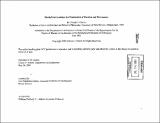| dc.contributor.advisor | Ann Pendleton-Jullian. | en_US |
| dc.contributor.author | Osborn, Connie J. (Connie Jo), 1969- | en_US |
| dc.contributor.other | Massachusetts Institute of Technology. Dept. of Architecture. | en_US |
| dc.date.accessioned | 2012-02-29T17:26:36Z | |
| dc.date.available | 2012-02-29T17:26:36Z | |
| dc.date.copyright | 2001 | en_US |
| dc.date.issued | 2001 | en_US |
| dc.identifier.uri | http://hdl.handle.net/1721.1/69429 | |
| dc.description | Thesis (M.Arch.)--Massachusetts Institute of Technology, Dept. of Architecture, 2001. | en_US |
| dc.description | Includes bibliographical references (leave 45). | en_US |
| dc.description.abstract | Other than the martial component, the primary concern for many of the martial arts is answering the question, "what is self?". The task of answering that question has historically belonged to the martial arts to the extent that they both came out of Buddhist schools of thought. For many of the martial arts self knowledge is one of the principle components. Both Buddhism and Taoism talk about a 'way' of the world, which is also the 'way' of self. Self is the same for everyone as all beings are cut from the same cloth of self. When one asks the question "what is self?", it is quite surmising to hear that self has no inherent features. We have all heard the Buddhist claim that 'all is void', and will probably be more surprised to discover that this means that there is in fact no self at all. The significance of this is revealed when one experiences that the nature of all things is change. This is why there are no features to self, as soon as one defines self, that limited definition falls away and is replaced by a new one. The discovery of this is not as efacing as it may seem, as it offers in exchange for a fixed self, one that can accommodate all things. It is void that permits the presence of things. According to Buddhist thought, all suffering arises from the desire to have things remain the same. Accepting that they won't or can't liberates the self to the enjoyment of being in present time. The immediacy and inherent meaning in all things becomes infinitely available. Within change it is evident that all things are continuous, without distinction one from the other. In every sense, self belongs to the greater body of all existence. In martial arts the practice of meditation is essential. The first lesson of meditation is often to simply observe ones breath. In the observation of the full duration of breathing, the constancy of change becomes apparentand the experiencing of the exclusive truth of now is layed bare. In the performance of martial arts this is vital. As soon as the artists mind stops or fixes in a particular moment, fear may enter, or she may rely on thought rather than being to perform and thus lose the fluidity of free action and become victim to defeat. If in the design of a martial arts academy it was the intention of the architecture to provide evidence of change, it would not be necessary to create change because change is happening at all times and in all places. It may only be necessary to call attention to it. In tracing the lines of overflow of the Rio-Grande River for the course of forty recorded years, I reaffirmed the truth of change. While examining the discrepancy between and among each line I could not find the defining line of the river. I wanted to build th is into the architecture, and so this became my thesis. | en_US |
| dc.description.statementofresponsibility | by Connie J. Osborn. | en_US |
| dc.format.extent | 46 leaves | en_US |
| dc.language.iso | eng | en_US |
| dc.publisher | Massachusetts Institute of Technology | en_US |
| dc.rights | M.I.T. theses are protected by
copyright. They may be viewed from this source for any purpose, but
reproduction or distribution in any format is prohibited without written
permission. See provided URL for inquiries about permission. | en_US |
| dc.rights.uri | http://dspace.mit.edu/handle/1721.1/7582 | en_US |
| dc.subject | Architecture. | en_US |
| dc.title | Martial arts academy : an examination of duration and discrepancy | en_US |
| dc.type | Thesis | en_US |
| dc.description.degree | M.Arch. | en_US |
| dc.contributor.department | Massachusetts Institute of Technology. Department of Architecture | |
| dc.identifier.oclc | 49568805 | en_US |
